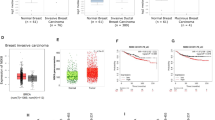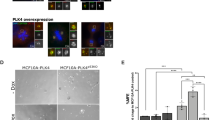Abstract
Tumorigenesis and tumor progression are associated with dysfunction of the nuclear transport machinery at the level of import and export receptors (karyopherins). Recent studies have shown that the nuclear import factor karyopherin-α2 (KPNA2) is a novel prognostic marker for poor prognosis in human breast cancer. Based on the well-defined hallmarks of cancer progression, we performed a detailed in vitro characterization of the phenotypic effects caused by KPNA2 overexpression and KPNA2 silencing in benign and malignant human breast cells. KPNA2 overexpression clearly increased proliferation of MCF7 tumor cells and further led to a reduction of cell–matrix adhesion in benign MCF10A cells, whereas cell migration was significantly increased (P<0.0001) in both tumor models. Remarkably, these individual effects of KPNA2 overexpression on proliferation, cell–matrix adhesion and migration resulted in an increased colony spreading of benign MCF10A breast cells and malignant MCF7 tumor cells (P<0.001), which is a hallmark of cancer progression. Conversely, RNA interference-mediated KPNA2 silencing caused a complete inhibition of MCF7 tumor cell proliferation and migration (P<0.0001). In addition, in these experiments apoptosis was increased (P<0.05) and formation of tumor cell colonies was reduced (P<0.01). Thus, KPNA2 overexpression provoked increased aggressiveness of malignant MCF7 breast tumor cells and induced a shift in benign MCF10A breast cells toward a malignant breast cancer phenotype. In conclusion, we demonstrate for the first time in experimental tumor models that forced KPNA2 expression drives malignant features relevant for breast cancer progression, while its silencing is required for the remission of those progressive phenotypes. This study gives clear evidence that KPNA2 acts as a novel oncogenic factor in human breast cancer, in vitro.
This is a preview of subscription content, access via your institution
Access options
Subscribe to this journal
Receive 50 print issues and online access
$259.00 per year
only $5.18 per issue
Buy this article
- Purchase on Springer Link
- Instant access to full article PDF
Prices may be subject to local taxes which are calculated during checkout








Similar content being viewed by others
Accession codes
References
Ben Porath I, Thomson MW, Carey VJ, Ge R, Bell GW, Regev A et al. (2008). An embryonic stem cell-like gene expression signature in poorly differentiated aggressive human tumors. Nat Genet 40: 499–507.
Brunet A, Brondello JM, L'Allemain G, Lenormand P, McKenzie F, Pages G et al. (1995). [MAP kinase module: role in the control of cell proliferation]. C R Seances Soc Biol Fil 189: 43–57.
Cavallaro U, Christofori G. (2001). Cell adhesion in tumor invasion and metastasis: loss of the glue is not enough. Biochim Biophys Acta 1552: 39–45.
Chook YM, Blobel G. (2001). Karyopherins and nuclear import. Curr Opin Struct Biol 11: 703–715.
Cunningham MD, Cleaveland J, Nadler SG . (2003). An intracellular targeted nls peptide inhibitor of karyopherin Alpha:NF-Kappa B interactions. Biochem Biophys Res Commun 300: 403–407.
Dahl E, Kristiansen G, Gottlob K, Klaman I, Ebner E, Hinzmann B et al. (2006). Molecular profiling of laser-microdissected matched tumor and normal breast tissue identifies karyopherin alpha2 as a potential novel prognostic marker in breast cancer. Clin Cancer Res 12: 3950–3960.
Dahl E, Sadr-Nabavi A, Klopocki E, Betz B, Grube S, Kreutzfeld R et al. (2005). Systematic identification and molecular characterization of genes differentially expressed in breast and ovarian cancer. J Pathol 205: 21–28.
Dankof A, Fritzsche FR, Dahl E, Pahl S, Wild P, Dietel M et al. (2007). KPNA2 protein expression in invasive breast carcinoma and matched peritumoral ductal carcinoma in situ. Virchows Arch 451: 877–881.
Ezeh UI, Turek PJ, Reijo RA, Clark AT. (2005). Human embryonic stem cell genes OCT4, NANOG, STELLAR, and GDF3 are expressed in both seminoma and breast carcinoma. Cancer 104: 2255–2265.
Flamini G, Curigliano G, Ratto C, Astone A, Ferretti G, Nucera P et al. (1996). Prognostic significance of cytoplasmic P53 overexpression in colorectal cancer. An immunohistochemical analysis. Eur J Cancer 32A: 802–806.
Gluz O, Wild P, Meiler R, Diallo-Danebrock R, Ting E, Mohrmann S et al. (2008). Nuclear karyopherin alpha2 expression predicts poor survival in patients with advanced breast cancer irrespective of treatment intensity. Int J Cancer 123: 1433–1438.
Goldfarb DS, Corbett AH, Mason DA, Harreman MT, Adam SA. (2004). Importin alpha: a multipurpose nuclear-transport receptor. Trends Cell Biol 14: 505–514.
Gorlich D. (1998). Transport into and out of the cell nucleus. EMBO J 17: 2721–2727.
Hall PA, Levison DA, Woods AL, Yu CC, Kellock DB, Watkins JA et al. (1990). Proliferating cell nuclear antigen (PCNA) immunolocalization in paraffin sections: an index of cell proliferation with evidence of deregulated expression in some neoplasms. J Pathol 162: 285–294.
Hanahan D, Weinberg RA. (2000). The hallmarks of cancer. Cell 100: 57–70.
Harreman MT, Cohen PE, Hodel MR, Truscott GJ, Corbett AH, Hodel AE. (2003). Characterization of the auto-inhibitory sequence within the N-terminal domain of importin alpha. J Biol Chem 278: 21361–21369.
Hu T, Liu S, Breiter DR, Wang F, Tang Y, Sun S. (2008). Octamer 4 small interfering RNA results in cancer stem cell-like cell apoptosis. Cancer Res 68: 6533–6540.
Karin M, Cao Y, Greten FR, Li ZW. (2002). NF-KappaB in cancer: from innocent bystander to major culprit. Nat Rev Cancer 2: 301–310.
Kau TR, Way JC, Silver PA. (2004). Nuclear transport and cancer: from mechanism to intervention. Nat Rev Cancer 4: 106–117.
Klein A, Wessel R, Graessmann M, Jurgens M, Petersen I, Schmutzler R et al. (2007). Comparison of gene expression data from human and mouse breast cancers: identification of a conserved breast tumor gene set. Int J Cancer 121: 683–688.
Lange A, Mills RE, Lange CJ, Stewart M, Devine SE, Corbett AH. (2007). Classical nuclear localization signals: definition, function, and interaction with importin alpha. J Biol Chem 282: 5101–5105.
Lauffenburger DA, Horwitz AF. (1996). Cell migration: a physically integrated molecular process. Cell 84: 359–369.
Lu W, Pochampally R, Chen L, Traidej M, Wang Y, Chen J. (2000). Nuclear exclusion of P53 in a subset of tumors requires MDM2 function. Oncogene 19: 232–240.
Mayhew TM, Muhlfeld C, Vanhecke D, Ochs M. (2009). A review of recent methods for efficiently quantifying immunogold and other nanoparticles using TEM sections through cells, tissues and organs. Ann Anat 191: 153–170.
Mortezavi A, Hermanns T, Seifert HH, Baumgartner M, Provenzano M, Sulser T et al. (2011). KPNA2 expression is an independent adverse predictor of biochemical recurrence after radical prostatectomy. Clin Cancer Res 17: 1111–1121.
Mosammaparast N, Pemberton LF. (2004). Karyopherins: from nuclear-transport mediators to nuclear-function regulators. Trends Cell Biol 14: 547–556.
Neve RM, Chin K, Fridlyand J, Yeh J, Baehner FL, Fevr T et al. (2006). A collection of breast cancer cell lines for the study of functionally distinct cancer subtypes. Cancer Cell 10: 515–527.
Noetzel E, Veeck J, Niederacher D, Galm O, Horn F, Hartmann A et al. (2008). Promoter methylation-associated loss of ID4 expression is a marker of tumour recurrence in human breast cancer. BMC Cancer 8: 154.
Olson MF, Ashworth A, Hall A. (1995). An essential role for Rho, Rac, and Cdc42 GTPases in cell cycle progression through G1. Science 269: 1270–1272.
Pankov R, Endo Y, Even-Ram S, Araki M, Clark K, Cukierman E et al. (2005). A Rac switch regulates random versus directionally persistent cell migration. J Cell Biol 170: 793–802.
Paris S, Sesboue R, Delpech B, Chauzy C, Thiberville L, Martin JP et al. (2002). Inhibition of tumor growth and metastatic spreading by overexpression of inter-alpha-trypsin inhibitor family chains. Int J Cancer 97: 615–620.
Pawlak G, Helfman DM. (2001). Cytoskeletal changes in cell transformation and tumorigenesis. Curr Opin Genet Dev 11: 41–47.
Perou CM, Sorlie T, Eisen MB, van de RM, Jeffrey SS, Rees CA et al. (2000). Molecular portraits of human breast tumours. Nature 406: 747–752.
Radu A, Moore MS, Blobel G. (1995). The peptide repeat domain of nucleoporin Nup98 functions as a docking site in transport across the nuclear pore complex. Cell 81: 215–222.
Raftopoulou M, Hall A. (2004). Cell migration: Rho GTPases lead the way. Dev Biol 265: 23–32.
Rayet B, Gelinas C. (1999). Aberrant Rel/Nfkb genes and activity in human cancer. Oncogene 18: 6938–6947.
Ridley AJ, Schwartz MA, Burridge K, Firtel RA, Ginsberg MH, Borisy G et al. (2003). Cell migration: integrating signals from front to back. Science 302: 1704–1709.
Runnebaum IB, Kieback DG, Mobus VJ, Tong XW, Kreienberg R. (1996). Subcellular localization of accumulated P53 in ovarian cancer cells. Gynecol Oncol 61: 266–271.
Sakai M, Sohda M, Miyazaki T, Suzuki S, Sano A, Tanaka N et al. (2010). Significance of karyopherin-{alpha} 2 (KPNA2) expression in esoph. Anticancer Res 30: 851–856.
Sandrock K, Bielek H, Schradi K, Schmidt G, Klugbauer N. (2010). The nuclear import of the small GTPase Rac1 is mediated by the direct interaction with karyopherin alpha2. Traffic 11: 198–209.
Sorlie T, Tibshirani R, Parker J, Hastie T, Marron JS, Nobel A et al. (2003). Repeated observation of breast tumor subtypes in independent gene expression data sets. Proc Natl Acad Sci USA 100: 8418–8423.
Stuart-Harris R, Caldas C, Pinder SE, Pharoah P. (2008). Proliferation markers and survival in early breast cancer: a systematic review and meta-analysis of 85 studies in 32 825 patients. Breast 17: 323–334.
Veeck J, Chorovicer M, Naami A, Breuer E, Zafrakas M, Bektas N et al. (2008). The extracellular matrix protein ITIH5 Is a novel prognostic marker in invasive node-negative breast cancer and its aberrant expression is caused by promoter hypermethylation. Oncogene 27: 865–876.
Wang CI, Wang CL, Wang CW, Chen CD, Wu CC, Liang Y et al. (2011). Importin subunit alpha-2 is identified as a potential biomarker for non-small cell lung cancer by integration of the cancer cell secretome and tissue transcriptome. Int J Cancer 128: 2364–2372.
Acknowledgements
The excellent technical assistance of Sonja von Serényi is thankfully acknowledged. This work was supported by a grant from the Mediacal Faculty of the RWTH Aachen (START program ‘Tumor marker and their function’ Project 1: Inflammation and Cancer).
Author information
Authors and Affiliations
Corresponding author
Ethics declarations
Competing interests
The authors declare no conflict of interest.
Additional information
Supplementary Information accompanies the paper on the Oncogene website
Supplementary information
Rights and permissions
About this article
Cite this article
Noetzel, E., Rose, M., Bornemann, J. et al. Nuclear transport receptor karyopherin-α2 promotes malignant breast cancer phenotypes in vitro. Oncogene 31, 2101–2114 (2012). https://doi.org/10.1038/onc.2011.403
Received:
Revised:
Accepted:
Published:
Issue Date:
DOI: https://doi.org/10.1038/onc.2011.403
Keywords
This article is cited by
-
Evaluation of the role of KPNA2 mutations in breast cancer prognosis using bioinformatics datasets
BMC Cancer (2022)
-
KPNA2 interaction with CBX8 contributes to the development and progression of bladder cancer by mediating the PRDM1/c-FOS pathway
Journal of Translational Medicine (2021)
-
Disease-specific alteration of karyopherin-α subtype establishes feed-forward oncogenic signaling in head and neck squamous cell carcinoma
Oncogene (2020)
-
USP1 inhibition destabilizes KPNA2 and suppresses breast cancer metastasis
Oncogene (2019)
-
Development of a pipeline for automated, high-throughput analysis of paraspeckle proteins reveals specific roles for importin α proteins
Scientific Reports (2017)



